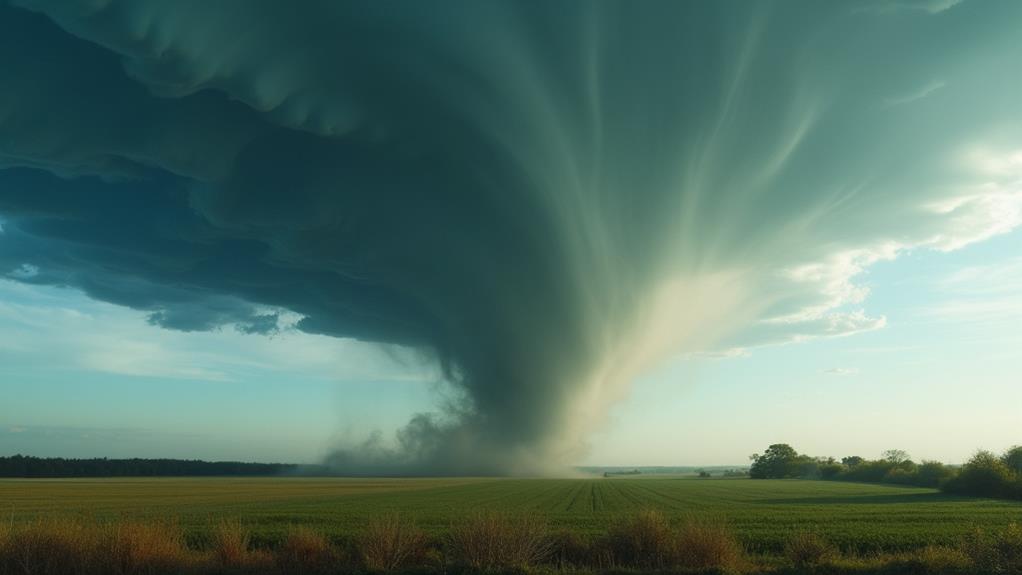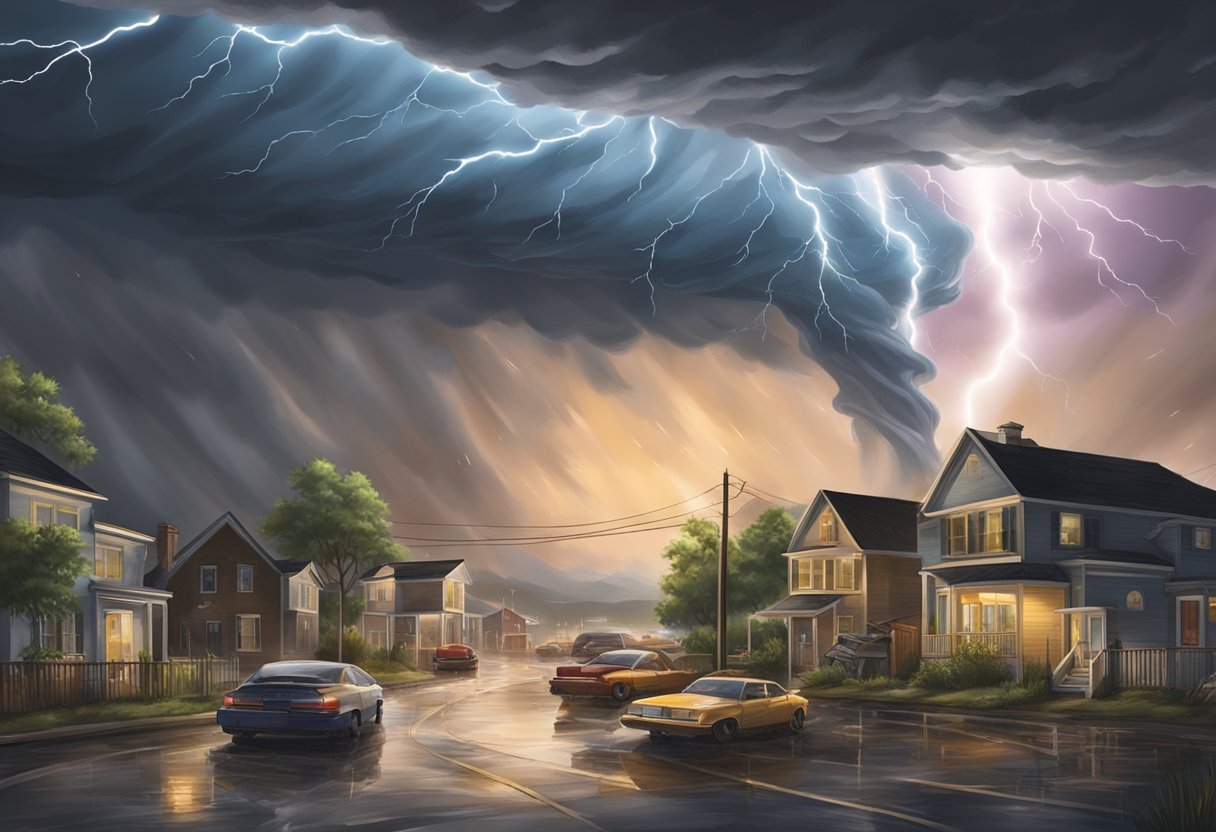Why Do Cities Struggle With Extreme Weather?
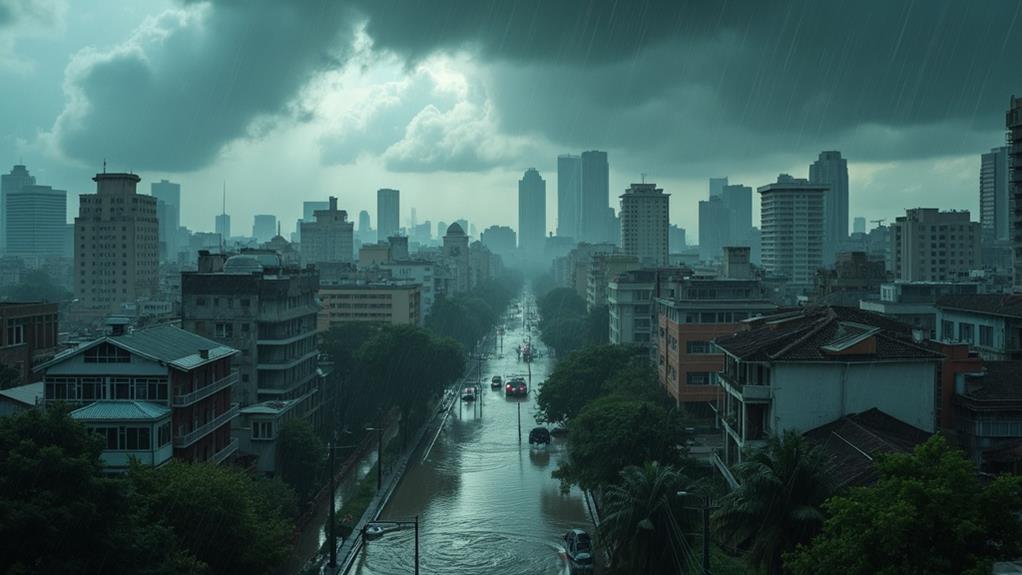
Cities struggle with extreme weather due to a mix of factors. Urban heat islands make cities hotter by absorbing solar radiation through asphalt and concrete. Global warming exacerbates this, increasing the frequency and intensity of heat waves. Poor infrastructure and inadequate resources further hinder resilience, particularly affecting low-income communities. Compounding these issues are high CO2 emissions from urban areas and the lack of thorough data for effective planning. Even basic services might be out of reach for many residents. If you want to understand the intricacies involved and investigate potential solutions, there's much more to uncover.
Key Takeaways
- Outdated infrastructure struggles to handle the increasing frequency of extreme weather events.
- Urban heat island effect and lack of green spaces exacerbate temperature disparities.
- Insufficient financial resources hinder robust climate adaptation measures in many cities.
- Disadvantaged populations face greater risks due to inadequate access to cooling resources and services.
- Poor air quality and housing conditions amplify health impacts during extreme weather.
Urban Heat Island Effect
The urban heat island effect, a phenomenon where city areas are noticeably warmer than their rural counterparts, has become a growing concern. Urban areas can be 3-4°C hotter than surrounding rural locales, with poor neighborhoods sometimes experiencing increases of up to 10°C. This temperature disparity arises from urban infrastructure like asphalt and concrete, which absorb solar radiation. High building density limits air circulation, exacerbating heat retention.
Climate change further complicates this issue by raising baseline temperatures by an average of 1.1°C, which heightens the urban heat island effect and increases the frequency of extreme heat days. These extreme heat events greatly impact public health, leading to thousands of premature deaths, particularly in low-income and minority neighborhoods. These areas often lack access to cooling resources, making them vulnerable populations.
Mitigation strategies can help alleviate these problems. Increasing green spaces and using reflective materials in construction can reduce heat absorption and improve air circulation. These measures not only help lower urban temperatures but also improve overall urban livability. Addressing the urban heat island effect is essential for protecting public health and adapting to the challenges posed by climate change.
Impact of Global Warming
Urban heat islands illustrate just one way cities bear the brunt of rising temperatures. As global warming accelerates, urban areas are responsible for a significant share of greenhouse gas emissions, which in turn fuel extreme weather events. You've probably noticed that heat waves are more frequent and intense, especially in cities. This is because urban areas trap heat, making them hotter than their rural counterparts.
Current projections suggest that global temperatures could rise by up to 2.9°C (5°F) by 2100, worsening the frequency and severity of extreme heat days. Imagine dealing with temperatures exceeding 35°C (95°F) almost every summer day—this could become a reality for urban residents. The economic costs are staggering, too. In the U.S., dealing with extreme heat might cost up to $500 billion annually by 2050.
Local governments face the challenge of enhancing climate resilience to protect residents and improve air quality. It's essential to implement adaptive measures like green roofs, increased vegetation, and sustainable infrastructure to mitigate these impacts. Without decisive action, 50-75% of the global population could be affected by life-threatening heat and humidity by the century's end.
Vulnerability of Urban Poor
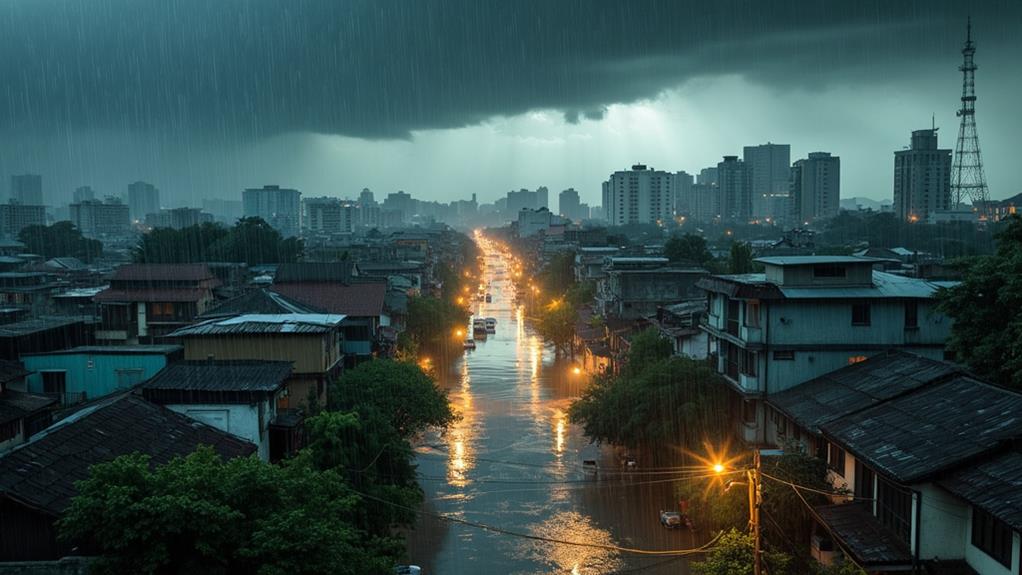
Living in slums, the urban poor face heightened risks from extreme heat due to their lack of access to cooling resources and crucial services. As one-third of urban dwellers don't have fundamental services, the disparities in access become glaringly evident. These gaps make the urban poor particularly vulnerable during extreme heat events. Poor air quality and inadequate housing conditions compound these issues, considerably impacting their health and well-being.
In regions like South Asia and Sub-Saharan Africa, the average number of extreme heat days could increase by 40 under a 3°C rise, disproportionately affecting vulnerable urban populations. These communities often experience systematic disparities in heat exposure, leading to severe health effects. As a result, the urban poor face more considerable challenges in adapting to extreme temperatures compared to wealthier areas that have better access to cooling and healthcare services.
Disadvantaged groups are more susceptible to heat-related illnesses, such as heatstroke and dehydration, due to these disparities. The lack of adequate housing and cooling options further exacerbates their vulnerability. Addressing these health risks requires urgent attention to improve living conditions and promote equitable access to fundamental services for the urban poor.
Resource Allocation Challenges
Resource allocation challenges in cities facing extreme weather are formidable, particularly when resources are scarce. You'll find that climate risks are especially pronounced in vulnerable areas where adaptation and mitigation strategies are underfunded. One-third of urban dwellers lack access to crucial services, making it tough to respond effectively to extreme weather events. The economic costs of extreme heat alone in the U.S. hit $100 billion annually, a figure that resource-strapped cities struggle to manage.
In South Asia and Sub-Saharan Africa, the average increase of 29 extreme heat days under a 3°C scenario exacerbates these challenges. Cities in these regions often lack the financial resources needed for robust adaptation measures. You'll notice that without strong political will, securing the necessary funds becomes even more difficult. This political inertia hampers the ability to scale up effective solutions, leaving these cities dangerously exposed to climate risks.
Facing these economic and resource constraints, cities must prioritize efficient resource allocation to withstand extreme weather. However, without adequate financial resources and political support, the gap between what's needed and what's available continues to widen, putting already vulnerable areas at even greater risk.
Inadequate Infrastructure
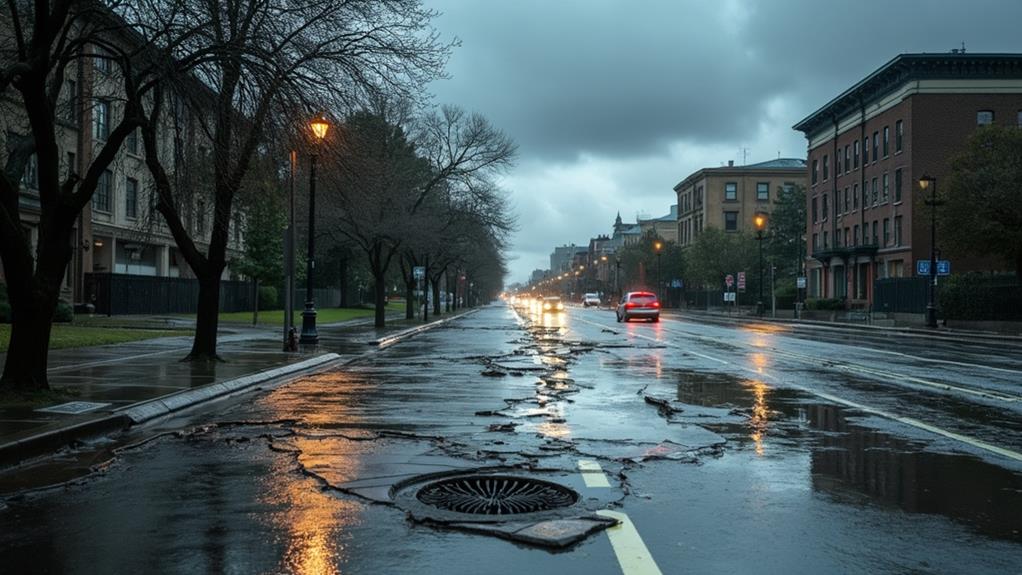
Against the backdrop of increasing extreme weather events, many cities find themselves grappling with inadequate infrastructure that can't keep pace with the rising challenges. Urban areas often have outdated systems that fail to accommodate the intensifying frequency of such events. Poor drainage systems are a prime example, leading to severe flooding during heavy rainfall. Projections estimate that flooding could cost urban areas $64 billion annually by 2050.
The urban heat island effect further exacerbates the situation, with temperatures in cities often 3-4°C hotter than surrounding regions. This is largely due to insufficient green spaces and the prevalence of heat-absorbing materials in urban areas. Vulnerable populations are particularly at risk, especially in resource-strapped cities where inadequate housing and infrastructure leave one-third of urban dwellers without access to crucial services.
Inadequate infrastructure doesn't just mean physical structures; it also includes the lack of thorough and resilient planning. Many cities struggle to adapt to climate change because their buildings and systems aren't prepared for current or future risks. The challenge is clear: without significant improvements, urban areas will continue to face escalating damage and disruption from extreme weather events.
Health and Safety Risks
Facing the brunt of extreme weather, urban residents encounter considerable health and safety risks. Extreme heat exacerbates underlying health conditions, leading to thousands of premature deaths during heat events. Vulnerable populations, such as the elderly and low-income communities, are particularly affected. Urban areas see a higher incidence of heat-related illnesses, with mortality rates projected to rise considerably as temperatures increase, putting further strain on health systems and emergency services.
Poor air quality in cities, combined with extreme heat, amplifies respiratory diseases and heat stress. Marginalized groups living in slums suffer disproportionately from these conditions. Systematic disparities in access to cooling resources result in poorer health outcomes for low-income neighborhoods, where residents may experience temperature increases of 10°C or more compared to wealthier areas.
During extreme weather events, the lack of adequate housing and crucial services in cities intensifies these health and safety risks. One-third of urban dwellers lack access to critical support systems, making them highly vulnerable. Altogether, the combination of extreme heat, poor air quality, and insufficient access to resources creates a precarious situation for many urban residents, particularly those in low-income neighborhoods.
Importance of Climate Data

Understanding the importance of climate data is fundamental for cities grappling with extreme weather events. Local authorities rely on accurate climate data to make informed decisions about urban planning and adaptation strategies. With detailed, neighborhood-level climate data, cities can better understand the specific impacts and inequities of extreme weather, allowing for targeted interventions.
Cities like Ahmedabad need tailored climate data to address the unique needs of different municipal departments. This data helps in identifying vulnerable areas, enabling urban planners to allocate resources effectively to mitigate climate hazards. Improved data availability is especially significant for resource-strapped cities, where limited information can exacerbate vulnerabilities to heat stress and other extreme weather impacts.
Continuous research and modeling are critical to predict future climate hazards. By collecting and analyzing ongoing data, cities can bolster their resilience efforts. Local climate data not only guides policy changes but also supports the development of robust adaptation strategies. Informed decision-making based on accurate climate data ultimately reinforces a city's ability to protect health, livelihoods, and indispensable services from the growing threats of extreme weather. So, investing in accessible, relevant climate data is a key step in building urban resilience.
Global and Local Emissions
While urban areas are thriving centers of activity and growth, they're also major contributors to global and local emissions. Cities face the challenging task of managing approximately 70% of global CO2 emissions, largely from transportation and buildings. High energy consumption, especially from air conditioning, and industrial activities greatly contribute to air pollution and greenhouse gas emissions.
Climate change is raising baseline global temperatures by an average of 1.1°C, exacerbating the urban heat island effect. This phenomenon is intensified by urban infrastructure that absorbs and retains more solar radiation, leading to higher local temperatures. As a result, the economic costs of extreme heat in the U.S. alone are projected to soar from $100 billion annually to $500 billion by 2050, driven by urban emissions and climate impacts.
To combat these issues, cities must prioritize climate action, focusing on reducing emissions and shifting to renewable energy sources. However, one-third of urban dwellers lack access to necessary services, complicating efforts to mitigate emissions and adapt to extreme weather. Addressing these disparities is vital to enhancing urban resilience and reducing the detrimental effects of air pollution and rising global temperatures.
Adaptation and Resilience

As cities grapple with the intimidating task of reducing emissions, they also need robust strategies to adapt to and withstand extreme weather events. Urban adaptation requires integrating climate considerations into city development policies. Given the rise in extreme heat days—an average increase of 29 under a 3°C warming scenario—cities can't afford to overlook this.
High-resolution climate data is vital for identifying neighborhood-level impacts and inequities. This data allows you to tailor adaptation strategies that specifically address threats to health and important services in your city. One effective approach is investing in green infrastructure. Cities like Medellin have reduced urban heat by 2°C through green corridors, showcasing the potential of such investments.
However, resilience-building efforts often fall short due to political will and financial resource constraints. It's important to guarantee that emergency response plans reach vulnerable populations adequately. Without targeted outreach, these communities remain at significant risk during extreme weather events.
Ultimately, urban adaptation and resilience hinge on your city's commitment to thorough strategies and investments. By prioritizing climate considerations and leveraging high-resolution data, you can create a safer, more resilient urban environment.
Community and Organization Roles
Everyone has a role to play in combating extreme weather, especially regarding community and organization involvement. Community engagement is vital for effective climate action, as it empowers vulnerable populations with the knowledge and tools needed to face extreme weather impacts. By participating in climate initiatives, you help guarantee that these communities can build resilience and adapt more effectively.
Organizations like the Cities Climate Finance Leadership Alliance are essential in directing resources toward city-level climate initiatives. They help cities adapt to challenges posed by extreme weather, making certain that funds are allocated where they're most needed. Your support, regardless of donations or activism, can make a significant difference in translating research into tangible climate solutions.
Civil society also plays a significant role. As a member, you can advocate for climate solutions and support local governments in implementing policies to address extreme weather impacts. Collaborative efforts between organizations and communities improve the effectiveness of climate strategies, including diverse voices and perspectives in adaptation planning.
Your involvement matters. By engaging with and supporting these efforts, you contribute to a more resilient community ready to face the challenges of extreme weather.
Frequently Asked Questions
How Do Cities Affect Weather?
You affect weather in cities through urban heat, air pollution, and reduced green spaces. Dense infrastructure and poor land use lead to higher temperatures and altered weather patterns. Without proper urban planning and climate adaptation, cities lack infrastructure resilience against extreme weather. By rethinking how you design urban areas, incorporating more green spaces, and reducing pollution, you can mitigate these impacts and create more sustainable environments.
How Does Extreme Weather Affect Communities?
You'd think extreme weather would bring communities together, but it often exposes their weaknesses. Community resilience depends on disaster preparedness, yet social equity issues make it harder. Infrastructure challenges and economic consequences strain resources, while mental health impacts and public health crises surge. Emergency response teams scramble, often overwhelmed. When marginalized groups face the brunt, it's clear that extreme weather tests not just the weather but our very social fabric.
Why Are Cities Vulnerable to Climate Change?
Cities are vulnerable to climate change because urban infrastructure often isn't designed to handle extreme weather. Heat islands raise temperatures, worsening public health issues. Poor flood management and inadequate transportation systems complicate emergency preparedness. Limited green spaces reduce natural cooling and air circulation. Social equity concerns arise as marginalized communities face greater risks. You need thorough strategies to address these challenges and protect urban populations effectively.
Why Are Cities Bad for the Environment?
Cities are bad for the environment due to urban pollution and heat islands. You'll see habitat loss and poor waste management, which increase resource consumption and degrade air quality. Noise pollution adds to the problem, harming both humans and wildlife. Limited green spaces exacerbate these issues by reducing natural cooling and biodiversity, making cities less sustainable. Your city's design directly impacts its environmental footprint and general health.


